27-29 May 2008 SCREENINGS
New English Creation
Carte blanche given to Miranda PENNELL
This selection of new work from the UK brings together diverse explorations of moving image work from young artists as well as more established ones. Loosely grouped around three themes - performance, landscape & storytelling, and music - the programmes also reflect concerns with the human presence and human expression, interrogations of digital and filmic construction, and the ambiguities of documentary and fiction modes. These questions are frequently addressed with a degree of humour, and at their best produce works that are complex and multi-layered in their appeal.
TUESDAY 27 MAY 2008 - 9 PM
“Performances”
Here the human presence is by turn playful, enigmatic or a tool that articulates formal concerns.
Martin Coate's work wittily finds parallels between animal rituals and human culture and behaviour, Ben River's hand-processed film introduces the audience to a mysterious and unsettling pilgrimage, and Wood and Harrison bring a sheet of A4 paper into a relationship with two electric fans.
Ben Rivers, The Coming Race, 2006, 5 min. (16mm)
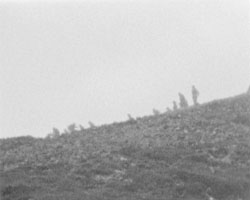 Ben Rivers, The Coming RaceA hand processed film in which thousands of people climb a rocky mountain terrain. The destination and purpose of their ascension remains unclear. A vague, mysterious and unsettling pilgrimage fraught with unknown intentions. The title 'The Coming Race' is after a Victorian novel by E.G.E. Bulwer-Lytton, about a race of people who live under a mountain.
Ben Rivers, The Coming RaceA hand processed film in which thousands of people climb a rocky mountain terrain. The destination and purpose of their ascension remains unclear. A vague, mysterious and unsettling pilgrimage fraught with unknown intentions. The title 'The Coming Race' is after a Victorian novel by E.G.E. Bulwer-Lytton, about a race of people who live under a mountain.
*Jayne Parker, Catalogue of Birds; book 3, 2006, 15 min. 30
A visual interpretation of Olivier Messiaen's music for piano.
*Marcus Coates, Dawn Chorus, 2006, 5 min.
Dawn Chorus is the latest in a series of films by British artist Marcus Coates, in which he attempts to make the human voice mimic birdsong. In this multi-screen video installation 19 singers reproduce a recording of a group of wild British birds singing at dawn.
*Wood & Harrison, Night and Day, 2007, 17 min.
(courtesy Stefan Von Bartha, Von Bartha Contemporary, Basel. 'Night and Day' will be shown in 'DIMENSIONEN' Von Bartha Contemporary, Basel opening 31st May)
John Wood and Paul Harrison have worked together since 1993, producing video works for single screen and installation.
*Night and Day is a large-scale projection which takes the viewer through the possible history of a room. Broken into a series of brief episodes, each part hints at an imagined use of the space, as a factory, a warehouse, an office. Every section begins in darkness, a light source is activated, a simple event occurs and the light is extinguished. This simple structure allows for surprising juxtapositions of objects, actions, time, mood and place. Combining static and moving camera shots and, for the first time in their work, exploiting fast-paced editing and additional sound, this work is at once elegant, chaotic, melancholic and comedic.
*Emily Wardill, Sick Serena and Dregs and Wreck and Wreck, 2007, 10 min, (16mm)
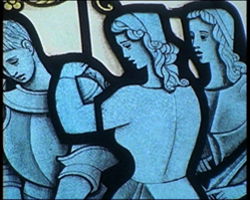 Emily Wardill, Sick Serena and Dregs and Wreck and WreckSick Serena... deliberately resists any settled reading, mixing medieval iconography and modern references, and undercutting its ritualised story with faltering delivery and slapstick comedy (the buns on one of the women's medieval headdresses are made from just that - buns). Wardill's films deconstruct their own visual languages, in a way that is inspired by an attempt to empower the viewer, but which also emphasises the irreducible strangeness of images.
Emily Wardill, Sick Serena and Dregs and Wreck and WreckSick Serena... deliberately resists any settled reading, mixing medieval iconography and modern references, and undercutting its ritualised story with faltering delivery and slapstick comedy (the buns on one of the women's medieval headdresses are made from just that - buns). Wardill's films deconstruct their own visual languages, in a way that is inspired by an attempt to empower the viewer, but which also emphasises the irreducible strangeness of images.
*Rachel Davies, We Got Old, 2002, 10 min.
We got old, stems from a collaboration between Rachel Davies and Britain-based choreographer from Hong Kong, Annie Li. The film's imagery, performing a complex doubling, and interwoven with an intricate yet nominal soundscape discloses an inter-cultural encounter that is presented intimately and disturbingly, at once nearing and distancing the viewer. Besides the encounter, the choreography of the piece spills with disorientations and uncertainties that make for provoking cinematic interventions, linked to the moments of the modern within film history, deriving from and broadening them further.
*John Smith, Throwing Stones, 2004, 11 min.
As the camera looks out through a barred window and the clock strikes four in a Swiss city, the death of Yasser Arafat provides the starting point for a journey back in time. "Throwing Stones" is the third video in the "Hotel Diaries" series, a collection of late night recordings made in foreign hotel rooms which relate personal experiences to contemporary conflicts in the Middle East.
*Wood & Harrison, Fan/Paper/Fan, 2007, 3 min. 16
Music and dance are the oblique subjects of Fan/paper/fan. An upright piece of paper is precariously supported on a table top, buffeted between the two opposing air currents supplied by electric table top fans.
Night and Day and Fan/paper/fan were all commissioned by Capture5, CAPTURE's commissioning fund and produced in association with Picture This. Whilst continuing the artists' ongoing investigations into architecture, performance, drawing, sculpture and film, these works suggest a range of new developments in both formal and conceptual terms.
WEDNESDAY 28 MAY 2008 - 7 PM
"Stories from another place"
Anchored in a sense of place, landscapes and built environments provide the basis for visual or narrative invention.
Sebastian Beurkner's cold institutional setting give way to intense moments of subjective revery, and Laure Prouvost presents a world where the mundane gives way to dark imaginings and unnerving sensations. Charlotte Ginsborg's video seems to move subtly from observations of actuality to fabricated fictions, as Rachel Reupke's seamlessly constructed Beijing landscapes slide between the present and an imagined future.
*Rachel Reupke, Now Wait for Last Year, 2007, 9 min. 02
This video work reflects a fascination with science fiction and the inherent problem of visualising the future. Shot in Beijing in 2006, it is inspired by a city in the throws of a construction boom where developers' hoardings intrude on every street, each displaying, in a pastel-soft style, an architect's visual of what is to come: the future of the city rendered as illustrated inserts into the reality of its present.
*Charlotte Ginsborg, The Mirroring Cure, 2006, 28 min.
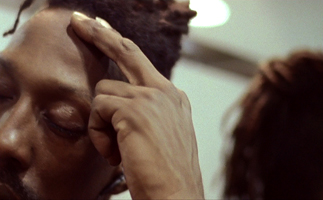 Charlotte Ginsborg, The Mirroring CureTracing the life of a large construction site from demolition to the completion of new office space, The Mirroring Cure focuses on the company secretary who decides to interview those employed around her. She wants to understand their relationship to work, their hopes, fears and anxieties. We witness her fascination with the Design Manager whom she discovers suffers from a loss of balance exacerbated by the large scale of the site. She becomes intrigued by the bizarre and surreal solution he develops to cope with his affliction, his 'mirroring cure'. Appearing initially as a documentary detailing the complexity of personal identities formed through being 'at work', as well as the effects of architecture on behaviour, the film begins to incorporate fictional elements leaving the viewer unsure as to where reality lies. To what extent the characters are acting remains ambiguous. Shot on 16mm over a two year period the film forms an intimate portrait of five working lives set against the visually arresting and constantly shifting architecture of the building development.
Charlotte Ginsborg, The Mirroring CureTracing the life of a large construction site from demolition to the completion of new office space, The Mirroring Cure focuses on the company secretary who decides to interview those employed around her. She wants to understand their relationship to work, their hopes, fears and anxieties. We witness her fascination with the Design Manager whom she discovers suffers from a loss of balance exacerbated by the large scale of the site. She becomes intrigued by the bizarre and surreal solution he develops to cope with his affliction, his 'mirroring cure'. Appearing initially as a documentary detailing the complexity of personal identities formed through being 'at work', as well as the effects of architecture on behaviour, the film begins to incorporate fictional elements leaving the viewer unsure as to where reality lies. To what extent the characters are acting remains ambiguous. Shot on 16mm over a two year period the film forms an intimate portrait of five working lives set against the visually arresting and constantly shifting architecture of the building development.
*Laure Prouvost, Abstractions quotidiennes, 2005, 12 min.
In her 'Abstractions Quotidiennes' series, bland visuals of peripheral urban spaces give way to colour-saturated monochrome screens that have the same transfixing power as James Turrell's light projections, but also act as a backcloth, a blank slate, for the abstract visions we might conjure from Prouvost's eccentric, uncomfortably emotive cameos of the quotidian. Here things are slimy, things drip and slither, they are unbearably hot or chillingly cold, there are threats of violence in a remorseless procession of the repulsive and the degraded, of which H.P. Lovecraft would be justly proud.
*Tim Shore, Cabinet, 2007, 18 min. 20
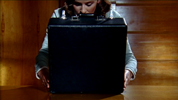 Tim Shore, CabinetIn Cabinet, Tim Shore pursues a disturbing message through the spaces of the American landscape. An associative framework of found footage, digital reconstruction and text form a meditation on identity, technology and the land. Shore's fragments of found imagery and sound evoke America's myths of itself, from its war record to its prairies and birdsong. Yet, this is shadowed by the dark spaces of the Unabomber in his forest cabin, and the repetitive sound of the typewriter, a reference not only to the latter's destructive manifesto but also to the fragmenting advance of technology.
Tim Shore, CabinetIn Cabinet, Tim Shore pursues a disturbing message through the spaces of the American landscape. An associative framework of found footage, digital reconstruction and text form a meditation on identity, technology and the land. Shore's fragments of found imagery and sound evoke America's myths of itself, from its war record to its prairies and birdsong. Yet, this is shadowed by the dark spaces of the Unabomber in his forest cabin, and the repetitive sound of the typewriter, a reference not only to the latter's destructive manifesto but also to the fragmenting advance of technology.
Sebastian Buerkner, Purple Grey, 2006, 8 min.
A vivid imagination can be a seductive but debilitating distraction from life. Twisted fantasies, associations and flashbacks offer an enticing escape, and even a mundane room may be made more bearable by mentally morphing space and time. But in this instance the unhindered and infinite virtual flood of imagery and meaning turns into an insensitive, dreary obstruction.
Semiconductor, Magnetic Movie, 2007, 4 min. 47
The remarkable secret life of invisible interplanetary magnetic fields, revealed as chaotic ever-changing geometries in man's visible environment. All action takes place around the NASA Space Sciences Laboratories, set to recordings of space scientists excitedly describing their visualisation techniques.
THURSDAY 29 MAY 2008 - 7 PM
“Music Lost and found”
A celebration of the relationship between image and music - music as structure, as a material object, as a sign, as a vehicle for performance, as raw energy and pleasure.
This program includes earlier work from the UK, including the Thermerson's 'film as music' experiments in London during 1944-5, Guy Sherwin's manipulation of movements of a train, film-speed, and music (1977-2000), and John Smith and Graeme Miller's harvesting and re-animating of discarded pieces of cassette tape found in the streets of East London in 2001.
Fransiska & Stefan Themerson, The Eye and the Ear, 1944-5, 10 min., (16 mm)
Four types of visual interpretation to the four songs comprising Julian Tuwim's 'Sopiewnie' with music by Karol Szymanowski.
*John Smith & Graeme Miller, Lost Sound, 2001, 28 min.
'The theme of fragmentation and decay is taken up by my favorite work here, the video Lost Sound (2001), made in collaboration with sound artist Graeme Miller. Divided into short sections titled by location, Lost Sound shows discarded audiotapes around London - strands clinging to a fence, trapped in the crevices of a tree trunk, intertwined with weeds. The sound track combines the voices and songs on the found audiotapes with ambient sounds recorded on location. Visually the audiotapes tell us almost nothing; they must be 'decoded' by the equipment that put them on the sound track. But we come to see that the signs, cars, and pedestrians in the videotape pose similar 'decoding' problems: what do they mean, where do they come from, who are they? A city that at first seems comprehensible is revealed as a layering of mysteries; we know no more about the passing humans from their images than we do about what's on the crumpled tapes .... Each section charts a different relationship between tape and urban scene, taking the viewer on a little unpredictable journey. Finally, as happens so often in Smith's work, the representational structure itself seems to break down. Titles and images are flipped left to right, undermining the readability of words, and men loading boxes onto a truck are seen in a repeated loop, foregrounding the arbitrariness of cinematic time as well as commenting on the repetitiousness of manual labor. Lost in an indecipherable maze whose rules change constantly, we see the city as a network of unpredictably shifting relationships and come to doubt even the sounds encoded in the tape fragments.
*Ann Course & Paul Clark, Ann(i)mated, 1993, 3 min.
Both her drawing skills and animation technique appear far from sophisticated. Her films look crude, simple and always very much the same. Ann Course makes her film works with the most modest means: drawing with a pencil or a pen on A4-paper, shooting with a simple video camera and often editing, rather than really animating. When things do move, it's usually in short cycles. Criteria like' original', 'daring', 'innovative' or 'revelatory' do not really apply to this artist's agenda. Authentic, provocative, archetypal and unconditional are already more appropriate terms. The first thing that hits the eye is the pure or downright brutal honesty that emanates from these simple, but very strong configurations. Superficially, the powerful, bold contours she uses to put her figures down on paper resemble the doodles of a bored schoolboy, who vents his boredom and frustrations in an exercise book or on a school desk. Explicit sexual fantasies, mutilation scenes, grotesque faces, ridiculous transformations and the occasional line or two of cryptic text.
In Ann(i)mated, Opening with mother's bulbous undulating vagina protruding from beneath her dress, child in arms. "To begin to start could never happen, to start at the beginning could be the end."
*Guy Sherwin, Rallentando, 1977/2000, 9 min. (16mm)
Movements of acceleration and deceleration of a train, speed of projection of film and music resulting from Pacific 231, symphony of Arthur Honegger dedicated to the engine.
*Guy Sherwin, sountrack, 1977/2000, 4 min. (16mm)
His subsequent film works, often including live elements and serial forms, are characterised by an enduring concern with light and time as the fundamentals of cinema.
*Jayne Parker, Foxfire eins, 2000, 12 min.
Performed on film by 'cellist Anton Lukoszievize, FoxFire Eins natrimpentothal (1993), is the name of a solo composition by Helmut Oehring. In FoxFire Eins the 'cellist must play with both hands plucking and striking the strings which are tuned down a perfect fourth. The child of profoundly deaf parents, Oehring's first language was signing. Oehring hears music as gestures - for him music comes out of movement.
*Sebastian Buerkner, Peak Project, 2005, 6 min.
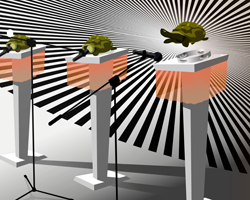 Sebastian Buerkner, Peak ProjectPeak gives a backstage insight into an improbable theatre production. Sets are built, equipment tested and surreal characters rehearse their acts or just kill time. Theatrical visual illusions suggest the possibility of bending time and space, while stage props are alive and form a natural part of the cast. Their arrangements form a collection of allegories in the language of theatrical symbolism; pre-production turns out to be a space where unreal forms can rehearse their future existence. We are left to guess what kind of play they might perform, or when the curtain will rise...
Sebastian Buerkner, Peak ProjectPeak gives a backstage insight into an improbable theatre production. Sets are built, equipment tested and surreal characters rehearse their acts or just kill time. Theatrical visual illusions suggest the possibility of bending time and space, while stage props are alive and form a natural part of the cast. Their arrangements form a collection of allegories in the language of theatrical symbolism; pre-production turns out to be a space where unreal forms can rehearse their future existence. We are left to guess what kind of play they might perform, or when the curtain will rise...
*Ann Course & Paul Clark, Recruitment Video, 2000, 2 min.
Hate it all head stomping for the good of all. Contains amazing stage dive.
PRACTICAL INFORMATION
NEW ENGLISH CREATION
Carte blanche given to Miranda PENNELL
Tuesday 27 May 2008 – 9pm: «Performances»
Wednesday 28 May 2008 – 7pm: «Stories from Another Place»
Thursady 29 May 2008 – 7pm: «Music Lost and Found»
*With the presence of Miranda PENNELL*
(27 - 29 May : exhibitions specially closing at 7 pm)
General admission: 10.-
Reduced admission: 6.-
3 showings (3evenings) 20.-/ 12.-
